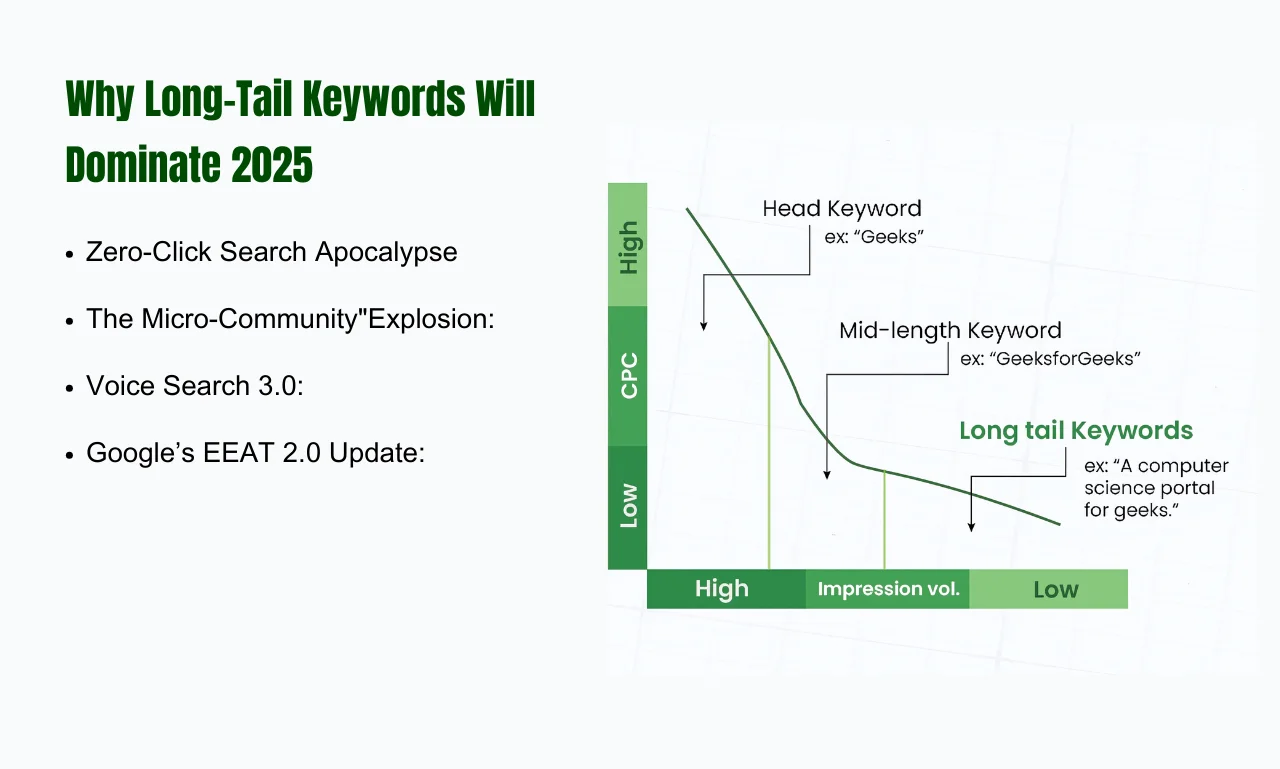Thinking about what are long tail keywords? Long tail keywords are less competitive and more specific, longer phrases of more than three keywords. From the Search Engine Optimization (SEO) point of view, such keywords reflect the user’s intent and are more specific to the target audience. Impact of such keywords on relevance and conversion rate is very high.
Just have a look at long tail keywords examples:
- Top Digital Marketing Agency in Dubai
- Top SEO Agency in Dubai
- Top Video Production Agency in Dubai
- Top Lead Generation Agency in Dubai
Although these keywords are a little longer, but more specific regarding the niche and user intent. After research, you will find that such keywords have a low research volume on keyword research tools.
In this detail guide, you will learn everything related to a long tail keyword and why it is a perfect hyper targeted SEO strategy.
The Evolution of Long-Tail Keywords: From 2004 to 2025
Over the period of time long-tail keywords have evolved a lot due to the advancement in the search engine algorithms. Let’s talk about different phases of evolution in more detail so you get a better clarity about it.
2004-2010: The Birth
In 2004, the idea of the Long Tail by Chris Anderson got entangled with some of the early SEO techniques. Long-tail keywords were recognized as instruments aimed at targeting narrow market segments. More emphasis was placed on particular and frequently ignored words in the websites to gain traffic. This period is considered as the basic guideline for the modern SEO techniques, with a focus on the relevance of content.
2015-2020: The Golden Age
At that time, long-tail keywords had been on the rise. The changes in the search engines included features such as “near me” searches. In addition, the increase in the popularity of mobile devices also transformed the way users searched for information on the Internet. SEO strategies deemed suitable for these changes to enhance the optimization of local-based searches and the optimization of mobile-friendly websites. The Golden Age was characterized by several changes in the way search engines processed the queries from the users.
2020-2024: The AI Disruption
During these years, Artificial Intelligence started to become more involved in the process of SEO. Under the utilization of such modern developments as BERT and ChatGPT, search engines could easily identify intents in users than before.
Moreover, with the emergence of semantic saturation, AI gained the capability to draw out context and even nuanced variations in the search queries. It brought about a new era of web-based SEO, most of which relied on the use of Artificial Intelligence which aims at conceptual understanding of the user’s query and look for an accurate match.
2025 & Beyond: Neuro-Semantic Keywords
Beyond 2025, we expect that specific neuro-semantic keywords will be developed. As stated by Zuckerberg, in the future SEO trends may be driven by Neural link. This could mean that search engines are capable of taking into account the user intent, emotional and contextual factors among others. Neuro-semantic keywords are referred to as search experiences of the future that may be more natural and personal.
Redefining Long-Tail in 2025: Beyond “3-5 Word Phrases”
When revisiting the long-tail keywords for the year 2025, we are beyond the thought of the 3-5 word terms. The new formula is Search Intent + Emotional State + Contextual Variables. This means that the keyword targeting will become broader and viewed from a different perspective.
The 5D Long-Tail Framework:

Device-Specific Intent:
Searches in 2025 will probably be based on the intent of the device. Mobile, tablet and the normal Search Engine Results will always be optimized to correspond to the screen size of the device in use. This enables the provision of suitable and smooth user interaction across the platforms.
Biometric Triggers:
As the technology in biometrics evolves, the search engines could incorporate data like heart rate and even eye movement in order to identify the level of interest and emotions of the user. This information may help to filter the results and make them closer to the user’s current emotional and physical condition.
Localized Zeitgeist:
Knowledge of cultural characteristics will again become important because there will be a need to identify the current spirit of the society located in given places.
The context to be taken in by search engines will include events, pop culture, and regional peculiarities as a means of filtering highly targeted information to netizens. This methodology also ensures that the search results meet the cultural relevance and context of the consumers.
AI-Persona Mirroring:
AI will further create social account personas for users specific to their behaviors and likes. These personas would be employed as a way of mimicking what users want to find, and result in the delivery of content that would emotionally appeal to them. It also makes the process easier and assists in making the customers satisfied or engage more into the website search process.
Ephemeral Keywords:
Storied and streaming is going to bring new keywords into the mix in the form of material that is short-lived. Picking your keywords from these topics offers marketers the possibility to connect with the audiences at the right time, when such a topic is popular.
Why Long-Tail Keywords Will Dominate 2025?
Looking into the future up to 2025, it is possible to presume that such highly specified keywords will remain relevant in the SEO field. Let’s investigate the reason behind the emergence of this phenomenon in more detail.

Zero-Click Search Apocalypse:
One major emerging trend in this regard is identified as zero-click search apocalypse. Analyses of current trends indicate that 82% of the generic keywords will be responded by smart bubbles such as Google’s Knowledge Graph in the upcoming years.
This means that the users will get answers to their inquiries without having to click on any other link. Ultimately, brands will have to look to the long-tail keywords and phrases for better results.
These extended and specific phrases contain more of the keywords, and therefore make the content rank higher and more useful to the users.
The “Micro-Community” Explosion:
Another factor that has given boost to long-tail keywords is the increase in micro-niches. With the further evolution of digital platforms, more and more niche markets appear on the market.
As the current generation is searching for information that is on their areas of concern. These micro-communities can therefore be well targeted using long-tail keywords because of the focus that these keywords display. They enable brands to target a specific audience through compelling and intent-oriented content that creates a stir in their business.
Voice Search 3.0:
With the development of technology, many people are opting to use the voice search for several reasons. This trend will remain on the rise in the subsequent versions, namely Voice Search 3.0.
With such advances in voice search, the results begin to extend their understanding of words, especially when placed in the form of a long-tail keywords question. For instance, rather than stating the idea as “best smartphones,” a person may inquire, “What are the best affordable smartphones for college students?”
In the case of voice search queries, long-tail keywords will indeed be more effective than general keywords due to the specificity it brings to the search query.
Google’s EEAT 2.0 Update:
There are improvements on Google search algorithms, which are done to enhance search results. The future update of EEAT 2.0 focuses on four attributes, which are Expertise, Experience, Authoritativeness, and Trustworthiness. The high quality and reliability of the content that is to be created will have to meet some set standards if they are to enjoy high rankings.
Long-tail keywords also make this possible by providing detailed information on certain topics, which is more preferable by the enhanced Google standards.
Tools of the Future: 2025’s Long-Tail Keyword Tech Stack:
Digital marketers always rely on sophisticated instruments to leverage the utilization of long-tail keywords. The following are some of the technologies that will make long-tail SEO a hot topic in the coming years:
AI Ethnography Tools:
The tools of AI ethnography will follow patterns of people’s behaviors online to reveal underlying truths and trends. These insights can shed light on the special interests and the long-tail keywords that would be helpful for marketers to come up with more focused content.
Glimpse 2.0:
Glimpse 2.0 is an analytic tool that captures actions carried out by a customer at different points in his or her journey involving an organization’s services.
This way, it helps the marketers in determining the business value of long-tail keywords and potential adjustment in strategies.
Meltwater’s Sentiment Cortex:
Such variables are vital in controlling and maintaining certain aspects of the digital archipelago due to the appreciation of sentiment analysis to measure public opinion trends.
Meltwater’s Sentiment Cortex involves the use of Artificial Intelligence through which sentiments can be determined concerning certain keywords or phrases. This tool assists specific marketers to ensure that they provide the right content that will be perceived well by the users.
Voice Data Scrapers:
As voice search increases, voice data scrapers will become inevitable. These tools help in gathering data of the questions being asked through voice search to enable users to understand the long-tail keywords.
It will be beneficial for marketers to apply this information when formatting their content for voice queries.
Quantum Keyword Clustering:
Quantum keyword clustering provides solutions for business people that apply the methods of quantum computing to analyze the large amount of data.
This made it easier for marketers to find patterns of related long-tail keywords that are otherwise difficult to discover.
The Dark Side of 2025 Long-Tail SEO: Ethics, Over-Personalization, & Digital Claustrophobia
Long-tail SEO is a very effective strategy, and at the same time, there are some ethical issues involved with it. Below are some of the issues marketers should consider as follows;
Privacy Paradox:
These demands are best strengthened without compromising on the protection of customers’ right to privacy. GDPR 4.0 or other regulations and technologies such as Apple’s Neuro privacy Chip are an effort to protect the users.
As a Marketer, you need to treat this area vigilantly if you want to pay respect to the privacy of your customers.
The “Filter Bubble” Crisis:
Long-tail keywords also lead to Filter Bubble effect, where people are only actually shown content as per their preference or something, they would be interested in. This can deepen societal fragmentation.
In this case, marketers must do their best to offer the users multiple opportunities to consider.
Over-Personalization and Digital Claustrophobia:
Advergaming can cause digital claurophobia, meaning users are faced with messages that insist on customizing themselves in relation to content. This is something that marketers need to address and find the right balance.
As a marketer, it is your duty to provide the users with the best personalized content that fits their interests without enslaving them to the content.
The 2025 Long-Tail Content Playbook: Beyond Blogs & FAQs

With the progressing year closer to 2025, the whole digital world is changing and opening great prospects and challenges for SEO.
Here, we will discuss such trends as neuro-adaptive content, voice-first snippets, and augmented reality, micro-guided that are revolutionizing the SEO terrain.
Neuro-Adaptive Content:
Neuro-adaptive content is the new trend that is becoming increasingly popular. This type of content is more engaging as well as responsive to the user’s mood and interest to comprehend different content matter. Websites using neuro-adaptive techniques will be most satisfying and give better control and have a high customer retention rate.
For instance, an online learning platform may present lessons depending on the stress that the learner is under or the rate of learning.
Voice-First Snippets
Due to the people’s raw adoption of smart devices such as Alexa and Google Assistant, there is the need to transition to voice-first content. These snippets should be brief and to the point, and reply to the question as directly as possible.
For example, rather than having long articles, similar companies may post short, concise responses that these devices can digest and relay.
AR Micro-Guides:
Augmented Reality (AR) micro-guides are in fact an evolutionary alteration. They provide an environment for fully engaging the attendees by using both tangible and virtual reality.
A plan for an augmented reality app that would help a customer to move through a real estate virtually is a perfect example of this case. These micro-guides employ certain keywords in the AR layer and are optimally suited for carrying out advertising campaigns.
AI Co-Piloted Content:
We believe that artificial intelligence (AI) will have a significant contribution to content creation. The content authored by AI is produced in combination with human writers. It also enables a synergy between budget constraints and quality delivery through the pressure of competition as well as the constant competition for the client’s time.
For example, take a travel blog, here the AI can come up with rough concepts that would then be written by a human who adds originality to it.
Local SEO in 2025: Hyperlocal Long-Tails You’re Ignoring
Hyperlocal long tail SEO refers to those keywords that are very specific to a niche. Although such keywords have less volume, but are still very effective in a particular location and community.
Geofenced Keywords
Local SEO is becoming less general due to the geofencing of keywords. These keywords work well with a specific region, making it easier to feature on the targeted area, in the search results.
For instance, a restaurant owner can increase the visibility of the eating place for terms like ‘best Mexican food in Austin’ for the people within that location to see.
AR Layer Keywords
AR layer keywords are also very important to a business if it is involved in the use of AR technology. They used to help in enhancing content for AR experiences.
A retail store with products that are presented through AR can incorporate the keywords to fetch the store on the search engines and increase traffic flow.
Community-Specific Dialects
For local SEO, it is very important to focus on their distinct modes of expression that is commonly used by the members of a particular community. Forbidding paraphrasing too much from the original message and targeting language specific to the business culture can increase the communication’s effectiveness.
This implies that if a firm dealing in facilities such as Digital Marketing Services in Dubai, it is best to incorporate local informal language in its campaigns.
Future-Proofing Your Strategy: The 2030 Preview
If you want to build a future-proofing strategy, you have to incorporate or put focus on the keywords like brand-interface, AI to AI negotiation keywords and ethical long tail governance keywords.
Brain-Interface Keywords
When more and more technologies based on brain interface are going to appear, the terms related to the use of the brain interface will be established. Such keywords will be useful in the thoughts-in and are therefore an interesting area of SEO. Brain Interface keyword trends are still unknown to marketers, that’s why they should endeavor to research them.
AI-to-AI Negotiation Keywords
As different AI systems begin to operate and communicate with one another, the usage of AI-to-AI negotiation keywords will pertain. These keywords will help in trading and sharing of information among the AI systems. It is therefore important for you to know how such interactions can leave an impact on your online marketing strategies.
Ethical Long-Tail Governance
Ethical factors in SEO will also be given more importance. Ethical long-tail governance serves as a way of making the SEO practices as harmless and as open as possible. This entails being honest and not misleading people through the kind of information that you share with them.
Concluding Thoughts:
Long tail keywords in 2025 will be more focused on cutting-edge techniques and methods based on definite goals and technologies. Neuro-adaptive content and voice-first snippets, AR-based micro-guides, and AI co-pilot content are some effective tools to be adopted to compete with these advancements. Furthermore, related to local SEO, actively using such keywords as geofenced keywords, AR layer keywords, and community dialects, will benefit local interaction.
By following these principles, you can traverse through the dark waters of refined SEO and establish beneficial corporate growth for sustainable development in the era of globalization. In case of any doubt related to long tail keywords, feel free to contact Three Angle Marketing (Leading Digital Marketing agency in Dubai) experts.


